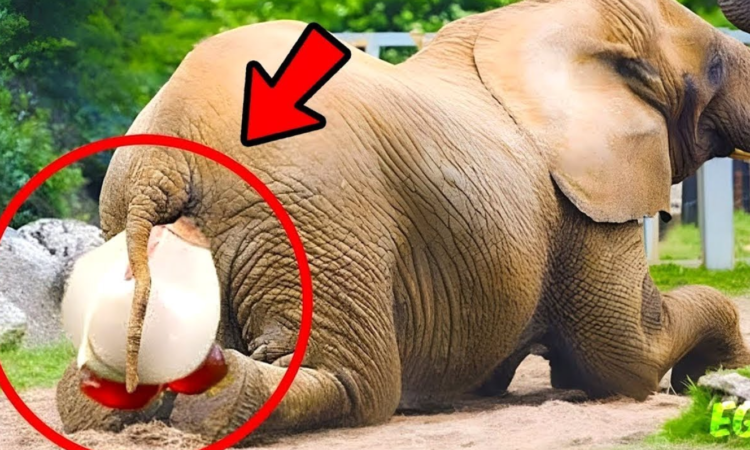
This incredible story takes place in Kenya, where experienced ranger Kenneth Ol Nashu and his team were patrolling Amboseli National Park, near the Tanzanian border. Their main job was to monitor the elephant population and protect them from poachers.
Among the herd of around 40 elephants, there was exciting news—one of the females, named Peru, was pregnant. The team eagerly awaited the arrival of a new baby elephant, but they also knew that pregnancy in elephants is long and challenging, lasting nearly 22 months.
Since Amboseli is a national park and not a zoo, veterinarians couldn’t perform the medical exams they would have liked. Instead, they observed Peru from a distance, watching for any unusual signs. As time passed, Peru started isolating herself, even from her firstborn daughter. While this wasn’t entirely unusual, what really concerned the team was that she began bleeding—a lot. The rangers feared she might be having complications or even a miscarriage. Given her age, it could be dangerous for both her and the baby.
Kenneth and his team kept a close watch on her. Then, one morning, he noticed a group of elephants gathered near a large marula tree, acting strangely. They stomped around restlessly, clearly distressed. The sky was cloudy, making it hard to see, so Kenneth drove toward them to investigate. When his headlights illuminated the scene, he saw Peru lying on the ground, breathing heavily. Her head tilted to one side, and she looked confused and weak. Something was seriously wrong.
Kenneth immediately called for backup. If Peru was in distress, the other elephants might react aggressively, so he stayed in his vehicle and waited. By the time the veterinarians arrived, night had fallen. Under the glow of the stars, they began their examination. One of the young veterinarians, Arian, carefully touched Peru’s rough skin, feeling her heartbeat. Her breathing seemed normal, and the rest of the elephant herd stood nearby, watching closely. They trusted the humans but remained alert.
When the vet took a blood sample, Peru’s leg twitched involuntarily, causing the elephants to stir nervously. Her firstborn daughter stepped forward, sensing something was wrong. The vet quickly analyzed the sample and found that Peru was severely dehydrated, and there was a possibility of a blood clot. She was immediately given fluids and medication to stabilize her condition. As they worked, Kenneth swatted mosquitoes from his face, guiding the team through the process. Slowly, Peru regained consciousness. The good news was that she didn’t seem to have a life-threatening disease, but the exact cause of her condition remained a mystery.
That night, Kenneth refused to leave her side. He slept in his jeep, waking up every time the elephants moved to make sure she was okay. Over the next week, he and his colleagues took turns monitoring her, joined by a young veterinarian-in-training named Aziz. Although Aziz was nervous, he was determined to help. He knew this was an important responsibility, and he wanted to make a difference.
Then, the big day arrived. Peru was about to give birth.
That night, Kenneth and Aziz were on duty. Aziz had learned that elephants often give birth at night, so he kept a close watch with his binoculars. Suddenly, he saw Peru becoming restless. He nudged Kenneth awake. “I think it’s happening,” he whispered.
Kenneth rubbed his eyes, took the binoculars, and confirmed it. “Good observation,” he told Aziz.
Moments later, the head and legs of a small elephant emerged. It was an incredible sight—Aziz had never seen an elephant birth before. Within half an hour, it was over. But just as Kenneth was radioing the base camp with the good news, something shocking happened.
Another baby elephant appeared.
Kenneth couldn’t believe his eyes. Peru had given birth to twins.
It suddenly made sense why her pregnancy had been so difficult—twin births in elephants are extremely rare and risky. Kenneth explained to Aziz that in all his years working in the park, he had never seen an elephant have twins. The last time it happened in Amboseli was nearly 40 years ago. Being a deeply religious man, Kenneth looked up at the sky, feeling as if he had just witnessed a miracle.
But their joy quickly turned to concern. Aziz, still watching through his binoculars, noticed something unusual. “Kenneth, is it normal for the baby to be bleeding?” he asked.
Kenneth focused his gaze and realized Aziz was right. One of the calves had a serious wound on its back. It must have been injured during birth or shortly after. This was bad news—newborn elephants are fragile, and an untreated wound could lead to infection.
The situation quickly became critical. Kenneth made an emergency call to the veterinary team, waking several members in the early hours of the morning. Despite the late hour, everyone responded immediately, determined to save the calf.
Peru, still exhausted but aware of her surroundings, allowed the veterinarians to examine her babies. It was as if she understood they were there to help. The team worked carefully, cleaning the wound and doing everything they could to prevent infection.
Fortunately, their efforts paid off. The little elephant recovered completely, bringing relief to the entire team. It was a huge success, not just for Peru and her babies, but for elephant conservation efforts as a whole.
This rare event was a reminder of the beauty and fragility of nature. The entire team felt honored to have witnessed it.
What do you think of this incredible story? If you enjoyed it, leave a like and subscribe to the channel. See you in the next video!




